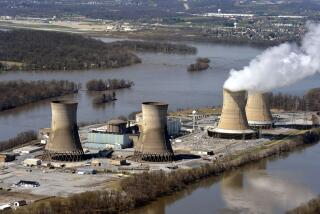Aid of Ex-Workers Sought in Seal Beach Toxic Project
- Share via
SEAL BEACH — Hoping to collect information that could help in a massive effort to clean up toxic waste at the Seal Beach Naval Weapons Station, the Navy is trying to find civilian and military employees who worked at an old NASA and Energy Department facility on the base.
The goal is to determine what toxic materials were used and where they might be buried. If left in the ground, the waste could pollute ground water or damage natural resources in the area, which contains a large national wildlife refuge.
The Navy’s environmental experts want to interview people who worked at a former National Aeronautics and Space Administration assembly plant on the base between 1963 and 1974, when rocket boosters were produced there for Apollo and Skylab missions. They are also seeking anyone who worked on a secret Department of Energy project, which operated on the site for several years after the NASA project ended.
“It’s important because it’s how we get information about what waste is here now,” said Navy spokesman Richard Williamson. “There are incomplete records, and in some cases there might not be records at all because there was no requirement to keep them in perpetuity.”
Agencies and companies involved in the rocket booster work were NASA, North American Aviation (now Rockwell International), the Department of Energy, Garrett Air Research and numerous aerospace subcontractors.
The Navy stresses that the workers did not violate any laws and will not be held responsible for the waste, since there were few rules regulating disposal of chemicals during that time.
“Nothing that was done in that time frame was done in an illegal manner,” Williamson said. “It was all in compliance with what was understood to be the best methods and technology of the day.”
The Navy is required to search for waste and clean it up under federal and state hazardous waste laws. Environmental officials believe that at least 26 areas at the 5,000-acre base, including some large landfills, have been contaminated with a variety of dangerous chemicals, including lead, mercury, solvents and battery acid.
Before the mid 1970s, military sites and industries across the country handled chemicals in ways that today are considered horrifying. Toxic waste at military bases was often dumped on the ground, set afire or even sprayed in the air for dust control.
Today, the Defense Department and others are required to follow a rigorous series of federal and state laws. Careful records outlining use, transport and disposal of toxic materials must be kept, and waste must be hauled to special treatment plants or dumps for disposal.
Around the country, former employees have turned out to be major sources of information in cleaning up toxic waste at military sites. In some cases, they were able to pinpoint exact locations where fuel was burned or drums were buried.
No one is sure how many people were employed at the NASA and Energy Department facility, although Williamson said it could top 5,000.
The workers producing the rocket boosters probably used a variety of toxic chemicals, including hexavalent chromium and trichloroethylene, which are both carcinogens.
“It won’t be difficult to find (the workers) as long as they are reading the newspapers,” he said. “What will probably happen is that somebody’s going to see the notice and say to a friend, ‘Hey Bob, didn’t you used to work down there when they were launching those missions to the moon?’ That’s how we’ve found people in the past.”
The military is also reviewing old records of its contractors to obtain information that might be helpful in finding buried wastes.
The Navy already conducted a major search in 1985 for employees who worked with chemicals at other portions of the Seal Beach base. That investigation is not yet completed, and Williamson said further information is still welcome.
No cleanup has begun yet. Resolving the 49-year-old base’s waste problems is expected to take the Navy until the year 2005.
More to Read
Sign up for Essential California
The most important California stories and recommendations in your inbox every morning.
You may occasionally receive promotional content from the Los Angeles Times.










